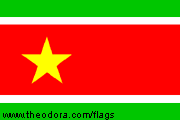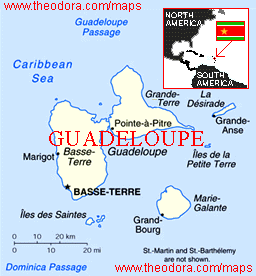 Guadeloupe
Guadeloupe Guadeloupe
GuadeloupeDecember 2017
Sunday December 10th
Captain’s Log: “Azura passed Dominica on her Starboard side at a distance of around five nautical miles through the night and ‘Stand By Below’ was scheduled for 06:00 for the arrival into Pointe a Pitre. The approach was technically challenging with Azura having to negotiate a fairly narrow channel on her approach to the harbour. With the Captain and Deputy Captain on the Bridge, the Bridge Team was now ready to progress with the transit. The pilot was embarked from the pilot boat at 06:13 and assisted the Bridge Team by providing invaluable local knowledge. For the manoeuvre, Captain Hoyt thrust the bow to Port and rotated the vessel through 180’c before setting the engines astern to approach the berth. Once in position, Captain Hoyt utilised the power of all six of Azura’a thrusters to move the vessel bodily towards the berth, allowing the mooring teams to send mooring lines making the ship fast to the berth. At 07:44 both gangways were ready for operation and the first of Azua’s guests made their way ashore.” (That would be us).
When we came off the boat, there was a tourist office. I asked (in French) if there were any car hire offices. When she didn’t understand me, my French was eventually reduced to “Hertz?”, “Avis?” She pointed to her left. Not knowing how far it was, I left Wendy outside the port’s exit by a metal fence on a scruffy road mostly used by taxis getting to and from the cruise ships. She said that while I was away that she saw two huge rats. One just stood there and looked at her for ages.
Meanwhile, I was following my nose and not seeing any sign of a car hire office. I decided to turn up a street where I could see shops/offices a few blocks away. Since it was early Sunday morning, the streets were deserted. I spotted an old man outside his flat and asked him. He didn’t understand me and took an age to climb his stairs. Then a woman eventually came down and said ‘Non’. Thanks for that. I retraced my steps back to the road I had started walking along and kept walking. There was a bus station. I asked someone there and they pointed behind the terminal. There was a Hertz office (closed) but another called Magaloc (open). One women spoke basic English but enough to allow me to rent a car for the day. I then tried to drive the car out of the car park and ended up going down two dead ends before finding a narrow lane to take me back to the bus station. I must have been gone nearly an hour. No matter. We had wheels and a destination.
The P&O Cruise guide said “This ‘butterfly’ settled on the Caribbean Sea centuries ago and belying the general reputation of the species, it has survived tribulations that would have destroyed the more fragile of its kind. Guadeloupe is actually two islands joined by a bridge that crosses the Riviere Salee hence its ‘butterfly’ appearance. Golden beaches rimmed with coconut palms, crystal blue seas, and a feeling that all is exotic and unusual sums up Guadeloupe. This French island has been called the ‘Emerald Island’ for its incredible flora of a thousand tropical scents.”
Basse-Terre is a mountainous island dominated by the Soufriere Volcano (1467m). It rains more often here than on the other island of Grande-Terre and is the region of tropical flora with lush greens, waterfalls, banana fields and volcanic craters. Grand-Terre, home of the sugar cane, windmills and white beaches with clear blue waters protected by coral reefs, is much flatter than its neighbour. It is lined with pebbled shores and beaches of ochre, brown, black, and pink.
Christopher Columbus landed on Basse-Terre in 1493 and named the island ‘Santa Maria de Guadalupe de Estremadura’. The name ‘Guadeloupe’ is derived from the Arabic meaning ’The River of Love’. In 1674 Guadeloupe was formally annexed by France. The British and French fought over it during the French Revolution with the British supporting the Royalists against the revolutionaries. The British were defeated and the guillotine did a thriving business in Pointe-a-Pitre were many aristocrats were executed. The 1815 Treat of Paris gave Guadeloupe to France and it has remained under French control ever since. The island’s population is around 450,000 and the Euro is the island’s currency.
Basse-Terre had spectacular scenery, mountains, waterfalls, and tropical rainforests. The best way to see this was to leave Pointe-a-Pitre and head along the ‘Route de la Traversee’, the cross country road (D23) from east to west which passed through the rainforest and the Parc Naturel – a lush, verdant land covering around 74,000 acres. On either side were tropical rain forests. Where sections of the road had been carved through rocks, the sides were draped in bright, almost illuminous green vegetation.
En route, the Cascade aux Ecrevisses was a 30ft tall natural waterfall. By the time we got there, we spotted an excursion bus from our ship just leaving the car park. We walked down to the waterfall along a concrete path with a gentle gradient. We even had the cascade to ourselves for 5 minutes before others arrived. Later on, we passed by the Parc des Mammelles at Baie Mahault and the Botanical Gardens but didn’t stop. Why would you when all the beautiful forests were all around you.
A twisty road descended to the coast where we turned south onto the N2, a coastal road which took us past nice bays such as the Plage de Malendure with its turquoise water. Off to our left was the ‘Reserve Cousteau’. Jacques Costeau had spent a lot of time in Guadeloupe. You could go snorkelling, diving or use a glass bottom boat to see the marine life but we didn’t have time today.
Continuing south we passed the small town of Bouillante and lots of small sandy bays. After Pointe de la Madeleine, we reached Basse-Terre, the political capital of the island which seemed to be dwarfed by Pointe-a-Pitre. At Riviere-Sens, we turned east onto the N1 and followed it back up the east coast. It was a faster, straighter road but mostly inland so we didn’t see the coast line.
Back at Pointe-a-Pitre, we joined the busy traffic which all seemed to be heading east with us on the N4 to get to the beaches on the island section known as Grand-Terre (the other wing of the butterfly). Early afternoon, the sun was high and temperatures hot. We passed by the Plage de Bas du Fort which was crammed with sunbathers and went onto St Anne. There was a stunning narrow white sanded beach here but nowhere to park. I jumped out to take a few photos.
Further on, we reached Saint Francis which also had a fine beach and we could park. A huge green lizard scuttled past into the shade. But time was pushing on, and with the heavy slow traffic, it had taken much longer to reach here than I anticipated and my idea to head north to Moule and do a circular return to Porte-a-Pitre was discarded to make sure we got back to the cruise ship on time. No matter, we had seen the beaches where our ships’s passengers paid for the ship excursions to take them there and back. I could never understand the mentality of people who did the cruise and when they came off the ship, they headed for the beach. I wanted to see the islands as much as possible.
The sun had gone in by the time we returned to an overcast Pointe-a-Pitre, the largest town with 17500 inhabitants and the dominant commercial centre and chief port of Guadeloupe. It is a mixture of old colonial buildings, high rise apartments, small typical Caribbean houses and an industrial area. We headed for the ‘Place de la Victoire’. This garden square bordered by colonial style houses with balconies and shutters, was the hub of the town. The royal palms and sandbox trees were planted in 1794. There was a guillotine installed at the same time and as many as 500 aristocrats were executed during the Guadeloupe version of the French Revolution. The current wooden benches in the park have guillotine blade shaped sides. Around the corner was the Cathedral de St Pierre et St-Paul built in 1807. It is often called the ‘Iron Cathedral’ because it is reinforced with iron ribs to withstand hurricane sand earthquakes. It was closed today.
Dropping Wendy off at the port entrance, I returned the car. Except that the office was closed. It was 4.00 and our ship left in an hour. An assistant turned up and said the owner was running late but she was coming. She arrived around 4.20 and I returned the car and then had to walk back to the port. I passed a large dead rat en-route. I think I boarded the Azura about 15 minutes before the gangways were taken away.
Guadeloupe is a very attractive island with great beaches and beautiful scenery and I think there would be enough to pass the time on a week’s holiday especially if you like hiking around the volcanic mountains covered in rainforests. It is very ‘French’ and while Pointre-a-Pitre is a bit run down in a typical French way, it’s just an average Caribbean port town.
Captain’s Log: “’Stand By Below’ was rung at 17:06 for departure with the last lines slipped at 16:43. Azura was thrust laterally to Starboard to open the distance on the cruise ship MSC Fantasia that was still berthed just ahead of Azura’s bow. Once well clear of the Fantasia, Deputy Captain Ward now had an open exit track from the berth. As the sun set, Azura made her way back out into the buoyed cannel to exit the harbour, ringing full away on passage at 18:15. Weather: Mostly sunny, light cloud. Temperature: 27’C. Wind: South Easterly, Force 1.”
That evening in the Oriental, we ate ‘Thai Shrimp Money Bag (mint and Thai basil salad with peanut & lime dressing’ followed by Fillet of Plaice with a prawn Mousseline. Dessert was a Tuscan coffee and hazelnut cake. It had been great to bag another new territory at last.
